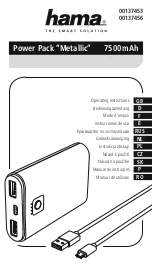
10
Operating Instructions
Routine Operating Instructions
While performing the steps listed below, refer to
the Features Drawing (previous page) for
additional reference, if necessary.
Make sure the Switch on the
Hobby Mill/Drill Machine is in its “OFF”
position.
1. Plug the Power Cord/Plug into a 120 volt,
grounded, 3-prong electrical outlet.
2. Check to make sure the Quill Feed is in its
full “UP” position.
3. Place the workpiece on the worktable.
Secure the workpiece to the worktable with
clamps or a vise (not provided).
A variety of tooling is widely available for use
with this machine. The spindle is a #2 Morse
taper, and accepts MT2 tooling threaded for a
3/8"-16 drawbar. The MT2 collet set (optional
accessory, not included) accepts endmills of
various shank diameters.
4. Insert the selected tooling into the spindle
and hold while threading the drawbar into
the tooling. Once the drawbar is seated,
further tighten the drawbar as necessary
with a wrench.
5. Adjust the
lifting handwheel
(14),
longitudinal feed handwheel
(12),
cross feed
handwheel
(11), and
fine feed handwheel
(8) as required for the work to be done.
6. Set the
high/low speed knob
(5) to the
speed range required.
7. Set the
high/low knob
until the letter “L”
appears on its dial. The Hobby Mill is set to
run at its low speed range (100-1,000 RPM).
8. Adjust
the
high/low knob
until the letter “H”
appears on its dial to run the machine at its
high speed range (200-2,000 RPM).
After the
High
or
Low
speed range has been
selected:
Note:
Higher speed is recommended for softer
materials or small holes. Lower speed is
recommended for harder materials and larger
holes.
9. Set
the
variable speed knob
(2) to adjust the
speed range.
10. Turn the Switch (1) from
Off
to either
Forward
or
Reverse
, depending on the work
to be done.
Important:
Do not attempt to turn the switch
directly from
Forward
to
Reverse
or from
Reverse
to
Forward
while the machine is
running. To change the rotational direction, fist
turn the switch to
Off
. After the machine stops
completely, select
Forward
of
Reverse
Test the machine in
Forward
and
Reverse
,
check the machine’s operation; looking for loose
or damaged parts, wobbling chuck, etc. If the
machine appears to be operating normally, the
Hobby Mill is ready for use.
11. Use the
longitudinal feed handle
and the
cross feed handle
to position the table and
to perform milling operations as desired.
After the work is completed:
12. Turn the switch (1) to
Off
.
13. Wait for the machine to stop completely.
14. Unplug the machine. Remove the workpiece
and remove the drill bit/cutting tool.
Head Raiser
Turn the
lifting handwheel
clockwise to raise and
counterclockwise to lower. Lock the head in the
desired position using head lock.
Quill Feed
position
– pull the
handle
down to lower and up
to raise.
fine feed adjustment –
push in on the clutch
lever, located on the fine feed handwheel. Turn
the fine feeding handwheel clockwise to bring
the tip of the quill up. Turn the fine feeding
handwheel counterclockwise to bring the tip of
the chuck down.
The fine feed handwheel has a range of full
spindle travel.
Note:
For normal, manual feeding, make sure
the Clutch Lever is pulled out (See Figure B and
the Assembly Diagram on page 15).
rotational direction –
turn the switch from
Off
to
Forward
to turn on the machine for a clockwise
rotation. Turn the switch from
Off
to
Reverse
to
turn on the machine for a counterclockwise
rotation.
Column Angle
Loosen four bolts in the back of the column of
the base of the machine for a left-to-right column
angle of
±
45º. Use the
angle indicator scale
for
approximate angles. Use a
machinist's angle
scale
for precision set-ups.
Summary of Contents for JHM-610
Page 12: ...12 Assembly Drawing ...
Page 16: ...16 Wiring Diagram ...


































